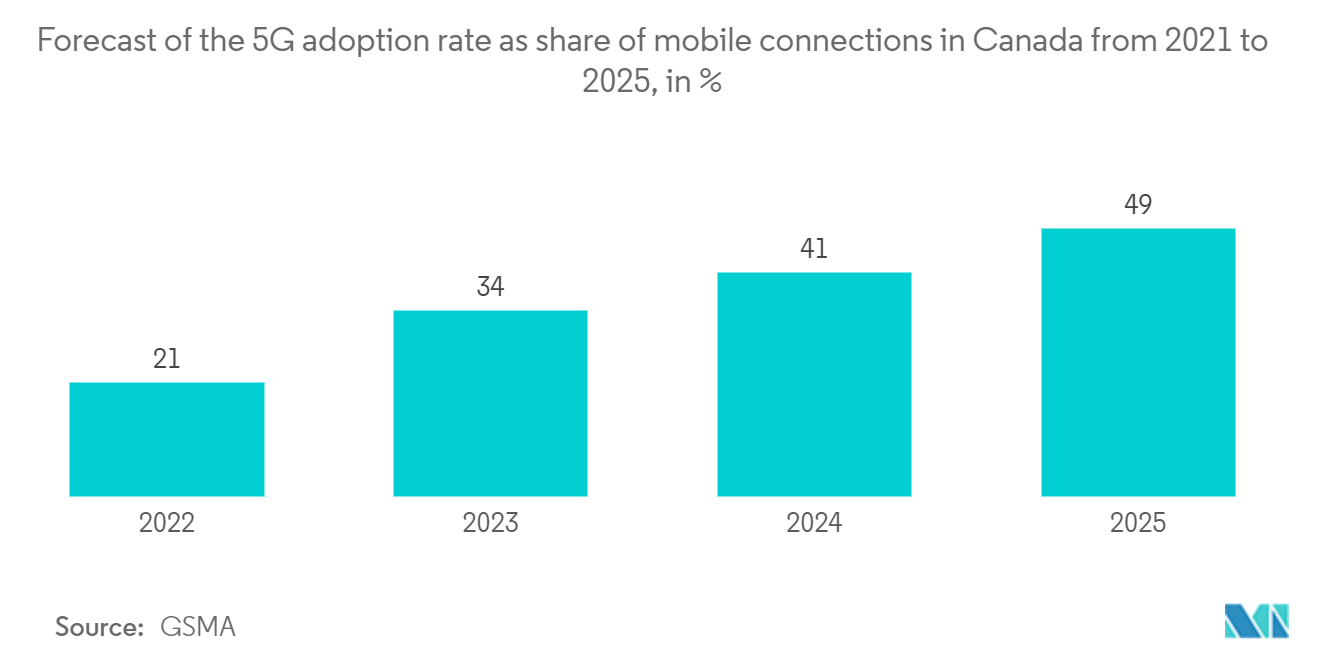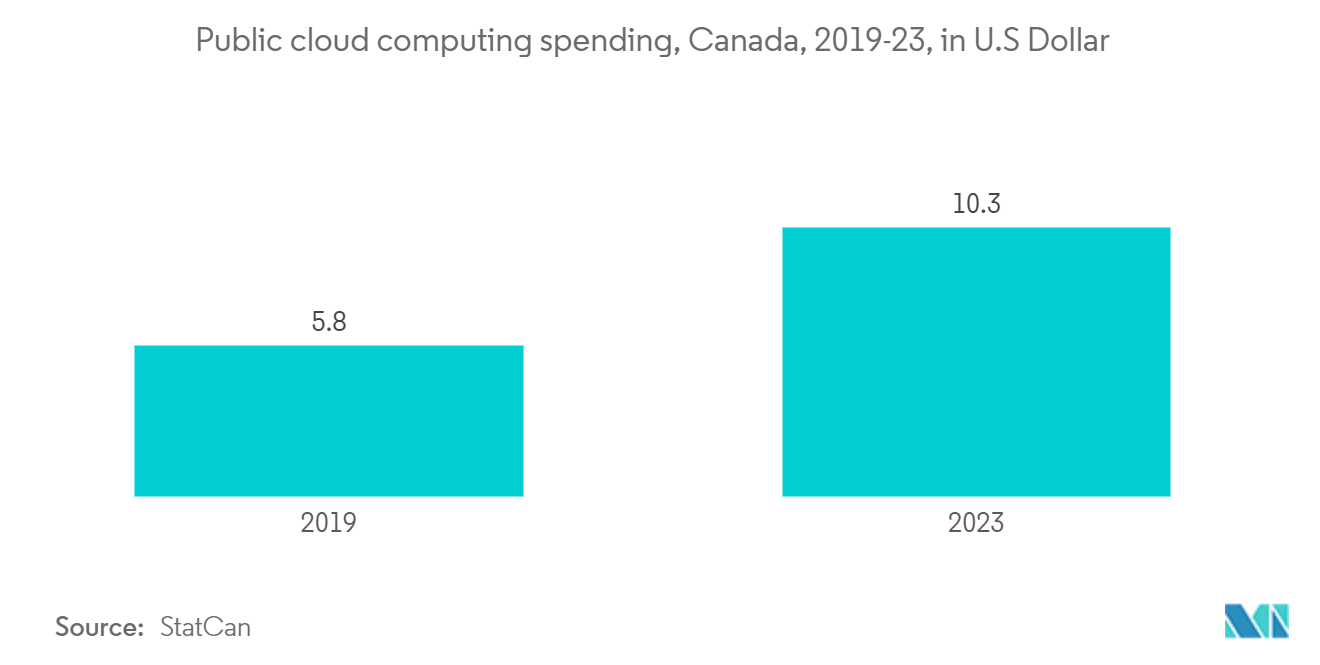Market Trends of Canada Telecom Industry
This section covers the major market trends shaping the Canada Telecom Market according to our research experts:
Accelerated 5G Rollout in the Country
- In Canada, the wireless sector is always evolving, and the launch of Fifth Generation (5G) networks will significantly develop. According to a recent analysis from Accenture, as 5G is implemented in use cases, cities and rural communities across Canada will experience tremendous economic and quality-of-life benefits, showcasing the impact it might have on the national level with the right support.
- As per a PWC report, by 2035, 5G is expected to enable an estimated USD 34 billion rise in GDP in Western Canada, with gains anticipated across all key industries. New use cases in the digital economy, including automated smart farming, connected and autonomous vehicles, and smart mining automation, will be made possible by 5G connectivity. These use cases will improve the use of inputs to reduce costs and provide opportunities to increase revenues through improved products and services. In Western Canada, the rollout of 5G is anticipated to have a large positive impact on the environment and society, including bridging the digital divide between urban and rural areas.
- By 2026, 5G wireless is predicted to add USD 40 billion to Canada's GDP, provide an additional 250,000 full-time employees, and increase consumer spending by 5%. Along with bridging the digital divide between urban and rural areas, 5G wireless technology will be crucial in aiding other industries in lowering greenhouse gas emissions. This is in accordance with the statements made by Robert Ghiz, President and CEO of the Canadian Wireless Telecommunications Association (CWTA), in his keynote speech at the May 2022 Wireless World Research Forum gathering.
- Adopting cutting-edge 5G enabled technology will allow other businesses to lower their carbon footprint. The utilization of mobile technologies, including 5G, across industries is predicted to have the ability to solve up to 23% of Canada's overall 2030 emission reduction targets, according to a report commissioned by CWTA. CWTA anticipates that the quick adoption of 5G would allow Canadian MNOs to reduce carbon emissions by up to 10 million tons between 2020 and 2030. The enhanced efficiency of 5G networks, which is fueled by improved data efficiency per unit of data transmitted, will primarily be responsible for this significant drop.
- The 3.5 GHz 5G service from the three Canadian carriers went live in June 2022, but there are already many expansion updates in the news. During the same time, Bell also confirmed that it would activate 3.5 GHz throughout southern Ontario, including Guelph, Kitchener, Waterloo, London, Barrie, and Mississauga. The new 3.5 GHz mid-band 5G represents a significant improvement over the prior 5G experience. Although most 2020-2021 5G rollouts added only a tiny amount of spectrum to the networks so they could be classified as 5G, this year's rollout doubles the number of airwaves used by carriers, enabling faster speeds and capacity.
- In June 2022, Telus noted the deployment of a 3,500 MHz spectrum will allow Montreal, Ottawa, Edmonton, and Victoria to enjoy a better 5G experience. The company added that the 3,500 MHz spectrum would also serve as the foundation for Telus' rural wireless high-speed internet service. Those residing in remote towns will have access to home internet rates of up to 100 Mbps, as it rolls out the 3,500 MHz spectrum across Canada. Telus intends to invest an additional USD 70 billion over the next four years in the spectrum, operations, and infrastructure to serve urban and rural clients.

More edge to cloud and IoT services
- Smartphones and other Internet of Things ("IoT") devices have changed the way life people across the country, and as more and more devices gain 5G capabilities coupled with our need for faster download speeds and undeterred signal strength, the auction for these coveted high-frequency licenses became much more critical to carriers all over Canada. Direct access to dependable cellular connectivity is essential for Canadian enterprises that are making innovations in the IoT arena. Six sections comprise Canada's telecommunications business, including local, long-distance, internet, wireless, data, and private lines, which are all relevant to building an IoT framework.
- The core of data-driven change is 5G innovation and edge computing. They will alter how everyone interacts and does business, including businesses, governments, and consumers, resulting in game-changing technologies and services. The Internet of Things and end-user connectivity are now available thanks to 5G, the next global cellular communications standard (IoT). It provides greater dependability, faster speeds, and more capacity. This opens the door for several further new use cases, including the widespread and cost-effective delivery of augmented and virtual reality over a multifunctional network with previously unheard-of flexibility, robotics, automated machines, increased factory automation, and many more.
- In early 2022, Bell Canada and Google Cloud together made the Canadian telco's network deployment of Google Distributed Cloud Edge. According to the firms, it is the first time essential network services have been implemented on Google Distributed Cloud Edge. Google Distributed Cloud Edge is a Google Cloud-managed service to operate 5G core and Radio Access Network (RAN) operations at the edge. It utilizes Anthos, a framework for managing applications and infrastructure provided by Google.
- As mega-corporations work to continue rolling out massive projects (Wireless Kiosks), like the one Bell Canada is implementing in Kingston, Ontario, IoT technologies are being studied and implemented gradually in Canada. Bell, a Canadian telecom firm, and Amazon Web Solution (AWS) Wavelength have developed a public multi-access edge computing (MEC) service to embed the latter's compute and storage service at the edge of Bell's 5G network. Since the previous three years, telecom and cloud corporations have collaborated often.
- The Canadian telecoms operator Telus and Google Cloud came into a 10-year strategic agreement in February 2021. Google and Telus will work together on brand-new services for a few important sectors. The agreement works on implementing Google's aim to grow new cloud operations in the telecom industry. The two businesses came to work together to develop fresh services and goods for several important sectors, including linked homes, agriculture, security, and healthcare. Telus also intends to use the Google Cloud Platform to update its own network and information technology.

